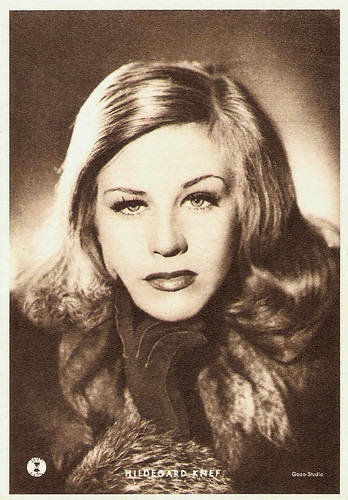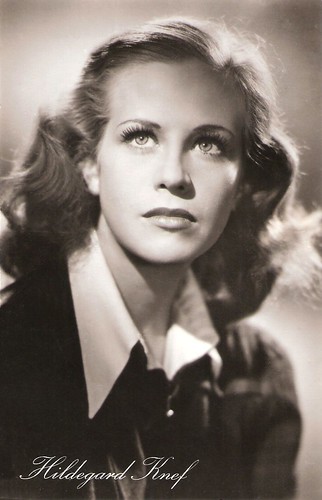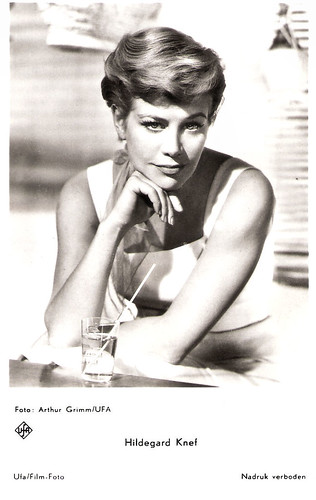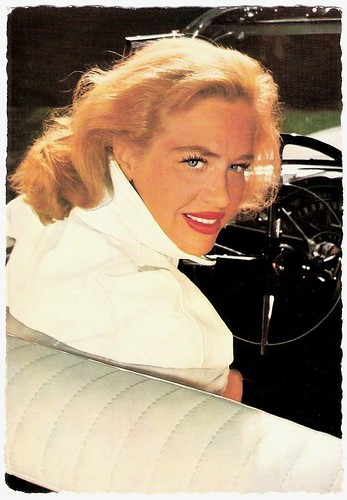
German postcard by Kunst und Bild, Frankfurt-Main. Photo: Gaza-studio.

German postcard by Photo-Kitt, München, no. 522. Photo: Camera Film / Kurt Julies / Herzog. Hildegard Knef and Hans Söhnker in Film ohne Titel/Film Without a Name (Rudolf Jugert, 1948).

German postcard by Wasmuth Verlag, no. WF 106. Photo: Stiftung Deutsche Kinemathek. Caption: Hildegard Knef, Hollywood 1948.

German postcard by Kunst und Bild, Berlin, no. A 482. Photo: Wesel / Styria / Junge Film Union / Herzog Film. Publicity still for Die Sünderin/The Sinner (Willi Forst, 1950).

Italian postcard by Edizioni S.I.P.Ci., Milano. Photo: 20th Century Fox. Hildegard Knef in The Snows of Kilimanjaro (Henry King, 1952).

Austrian postcard by Verlag Hubmann (HDH), Wien, no. 130. Photo: International Film, Wien / Regina Sonor. Hildegard Knef in La fête à Henriette/Holiday for Henrietta (Julien Duvivier, 1952).

West German postcard by Kunst und Bild, Berlin, no. A 625. Photo: Styria / Carlton / Gloria. Hildegard Knef in Alraune/Mandrake (Arthur Maria Rabenalt, 1952).
Berlin's voice
Hildegard Frieda Albertine Knef was born in Ulm, Germany, in 1925. Her parents were the Flemish tobacco merchant Hans Theodor Knef and his German wife Frieda Auguste Knef-Gröhn. Hildegard went to school to the Rückert-Lyzeum in Berlin-Schöneberg.
In 1942, she began to work as an artist at the painting department of the Ufa Film Studio. A year later, she made a screentest and became an acting student at the Babelsberg Film Institute, Ufa's training program. Even before the fall of the Third Reich, she appeared in several films, including Die Brüder Noltenius/The Noltenius Brothers (Gerhard Lamprecht, 1945), Unter den Brücken/Under the Bridges (Helmut Käutner, 1945), and Frühlingsmelodie/Spring Melody (Hans Robert Bortfeld, 1945), but most were released after the war.
To avoid being raped by the Soviet soldiers she dressed like a young man and was subsequently sent to a camp for prisoners of war. She escaped and returned to war-shattered Berlin where she played her first part on stage in the cabaret show 'Heute Abend um sechs' (Tonight at Six) with Viktor de Kowa.
She had her breakthrough in the first film released after World War II in East Germany, Die Mörder sind unter uns/The Murderers Are Among Us (Wolfgang Staudte, 1946), produced by the communist DEFA-Studio, backed by the Russians. Her powerful performance as a Holocaust survivor amid the ruins of postwar Berlin made her immediately a star. Over 4 million East Germans went to the cinema to see it.
She appeared also in the first West-German films Zwischen gestern und morgen/Between Yesterday and Tomorrow (Harald Braun, 1947) and Film ohne Titel/Film Without a Name (Rudolf Jugert, 1947) with Hans Söhnker, both backed by the Americans. In these films she symbolized war-shattered Germany and became ‘Berlin’s voice’ — learning to survive, stubbornly bouncing back and starting anew, without ever losing sight of the past. Film ohne Titel/Film Without a Name became commercially the most successful film of 1948 in West Germany.

German postcard for Die Mürder sind unter uns/Murderers Among Us (Wolfgang Staudte, 1946) by VEB Progress Film-Vertrieb, Berlin. Photo: DEFA, no. 14 M/300.

East-German postcard by VEB Progress Film-Vertrieb, Berlin, no. 7/319. 1957. Photo: DEFA.

German postcard by F.J. Rüdel Filmpostkartenverlag, Hamburg-Bergedorf, no. 81/2. Photo: Junge Film Union / Herzog / Foto Wesel.

Austrian postcard by Austriapost, Wien, no. 63. Photo: Styria / Carlton / Gloria / Drünjes. Hildegard Knef in Alraune/Mandragore (Arthur Maria Rabenalt, 1952).

West German postcard by Rüdel Verlag, Hambrug-Bergedorf, no. 339. Photo: 20th Century Fox. Hildegard Knef in Diplomatic Courier (Henry Hathaway, 1952).

German promotion card for Cinema Paris, Berlin. Photo: Allianz Films. Hildegard Knef, Michel Auclair and Dany Robin in La fête à Henriette/Holiday for Henrietta (Julien Duvivier, 1952).
Nude scene
In 1948 Hildegard Knef appeared on a cover of Life magazine and studio mogul David O. Selznick of 20th Century-Fox invited her to come to Hollywood. He offered her a contract - with two conditions: she should change her name to Gilda Christian and should pretend to be Austrian instead of German. She refused both and returned temporarily to Germany.
There she appeared in another influential role, Marina in Die Sünderin/The Sinner (Willi Forst, 1950), in which she performed the first (brief) nude scene in German cinema. The incident sparked one of the largest scandals in German film history and drew the criticism of the Roman Catholic Church, but also 7 million spectators. Her comment: "I can't understand all that tumult - five years after Auschwitz!"
During the 1950s she became an internationally active star, who travelled between the USA and Europe. She appeared in minor roles in Hollywood productions like Decision Before Dawn (Anatole Litvak, 1951), Diplomatic Courier (Henry Hathaway, 1952) starring Tyrone Power, Ernest Hemingway's The Snows of Kilimanjaro (Henry King, 1952) starring Gregory Peck, and the Film Noir Night Without Sleep (Roy Ward Baker, 1952). In these films, she was billed as Hildegarde Neff, reportedly because Americans couldn't pronounce Knef.
She also starred in such European films as Nachts auf den Straßen/Nights on the Road (Rudolf Jugert, 1951) with Hans Albers, Alraune/Mandrake (Arthur Maria Rabenalt, 1952) opposite Erich von Stroheim, the French production La fête à Henriette/Holiday for Henrietta (Julien Duvivier, 1952), Illusion in Moll/Illusion in a Minor Key (Rudolf Jugert, 1952) with Sybille Schmitz , the thriller The Man Between (Carol Reed, 1953) starring James Mason, and the flop Madeleine und der Legionär/Escape from Sahara (Wolfgang Staudte, 1958) with Bernhard Wicki.
In total, she appeared in 49 feature films, 19 of which were non-German productions. She was also successful on stage, appearing in 15 plays. Her Broadway debut as Ninotchka in Cole Porter's 'Silk Stockings' (1955-1956) is considered her greatest triumph – as she became the first German to succeed on Broadway. The New York Times wrote about her: "She gives an immensely skilful performance".

French postcard by De Marchi Frères, Marseille.

German postcard by Universum-Film Aktiengesellschaft (Ufa), Berlin-Tempelhof, no. CK-96. Retail price: 30 Pfg. Photo: Arthur Grimm / Ufa.

German postcard by Ufa, Berlin-Tempelhof, no. CK-94. Photo: Arthur Grimm / Ufa.

Dutch postcard by D.R.C. Holland, no. 3630. Photo: Arthur Grimm / Ufa.

Dutch postcard by N.V. Int. Filmpers, Amsterdam, no. 1056.

West German postcard by Schumann-Verlag, Berlin. Photo: Rank. Hildegard Knef in Subway in the Sky (Muriel Box, 1959). The German title was U-boot in dem Himmel.
Breast cancer
In the 1960s and 1970s, Hildegard Knef enjoyed success as a singer of German chansons, which she often co-wrote. The song she is best remembered for is 'Für mich soll's rote Rosen regnen' (It Shall Rain Red Roses for Me). She is also known for her version of the song 'Ich hab noch einen Koffer in Berlin' (I`ve Got a Suitcase Left in Berlin...), the title of which is still often cited in articles and in common speech throughout Germany.
Among her other film credits were as Pirate Jenny in a new version of Die Dreigroschenoper/The Threepenny Opera (Wolfgang Staudte, 1962), as a victim of a serial killer in the black comedy Landru (Claude Chabrol, 1963), and as Catherine the Great in Caterina di Russia/Catherine of Russia (Umberto Lenzi, 1963). She was sometimes compared to Marlene Dietrich, in that they both were, or were portrayed as, the liberated, self-confident woman. In Fedora (Billy Wilder, 1979) she played a character based on Dietrich and other legendary film stars.
Besides acting, Hildegard Knef published seven books. Her autobiography 'Der geschenkte Gaul - Bericht aus einem Leben' (The Gift Horse - Report of a Life) from 1970 is a candid, but not sensationalist, recount of her life in Germany during and after World War II. It became the best-selling German book after World War II. Her second book '>Das Urteil' (The Verdict) from 1975 was a moderate success. It was a no-nonsense account of her struggle with breast cancer.
In 1999 her last film hit the screens, Eine fast perfekte Hochzeit/An Almost Perfect Wedding (Reinhard Schwabenitzky, 1999). That same year her last album was released, '17 Millimeter', and she made her last TV appearance, singing 'Zum Schluss...' (At the end…) on the German TV show Herman & Tietjen.
Hildegard Knef endured more than 50 operations but her cancer-ridden and alcohol-wrecked body always bounced back. In 2002 she finally gave in. Aged 76, she died in Berlin, the city where she had moved back to after the German reunification. Her marriages to the American Kurt Hirsch and British actor David Cameron both ended in divorce. She was survived by her third husband, Paul von Schell, and her daughter with David Cameron, Christina (Tinta) Knef (1968).

German postcard by WS-Druck, Wanne-Eickel, no. F 37. Photo: Klaus Collignon.

West German postcard by Ufa/Film-Foto, no. 989. Photo: Charlott Serda.

West German postcard by Rüdel Verlag, Hamburg-Bergedorf, no. 615. Photo: Junge Film / Union / Herzog.

West German postcard by Rüdel Verlag, Hamburg-Bergedorf, no. 469. Photo: 20th Century Fox.

West-German postcard by Kolibri-Verlag, no. 945. Photo: 20th Century Fox.

German postcard by Rüdel Verlag, Hamburg. Photo: Lothar Winkler, Berlin.
Hildegard Knef sings 'Für mich soll's rote Rosen regnen'. Source: Master2Dam (YouTube).
Trailer Hilde (2009) with Heike Makatsch as Hildegard Knef. Source: HILDE der Film - offizieller Youtube Channel (YouTube).
Sources: Hal Erickson (AllMovie - Page now defunct), Yancey (IMDb), World Press Review, BBC News, Hildegardknef.de (German), Wikipedia, and IMDb.
1 comment:
What an amazing life! We recently lost a friend of ours to breast cancer at the age of 42, so Miss Knef's resilency is doubly impressive. Thanks Bob.
Post a Comment